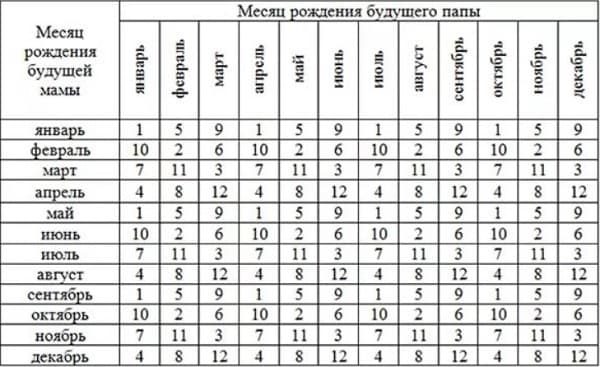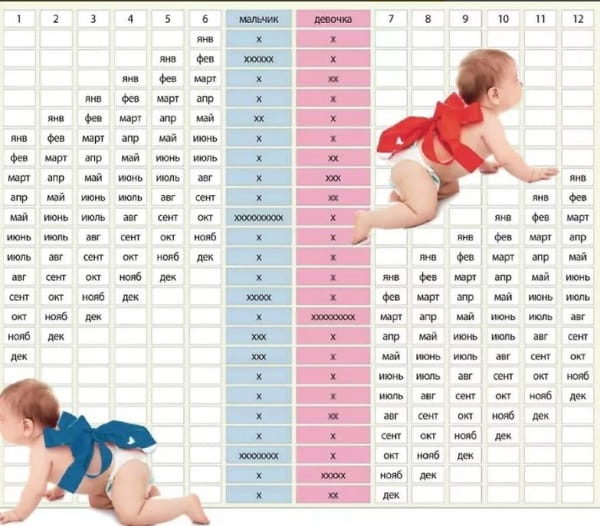Home / Health / Pregnancy
Back
Published: 02/28/2020
Reading time: 6 min
4
15035
4.7 / 5 ( 3 voices)
Most women who have just become pregnant already in the early stages of pregnancy wonder: how to find out the sex of the child without an ultrasound. Those mothers who already have children are especially interested in this. This is in order to buy everything you need and prepare yourself for the birth of a son or daughter.
There is a category of married couples who are trying to plan the sex of their future baby before conception. Unfortunately, not everyone succeeds.
Future parents use a variety of methods to find out who they are going to have before an ultrasound. All women relate to ultrasound examination differently. Someone considers it safe, and the second category of women is afraid of its harmful effects on the fetus, and the third category of women wants to do an ultrasound simply out of interest.
- How to determine the sex of a child without an ultrasound examination
- What do folk signs say on this topic? About signs associated with the mother
- About signs associated with the father
- Ovulation calculation
- Determining the sex of a child by blood renewal
How to determine the sex of a child without an ultrasound examination
Today, many methods have been developed with the help of which you can find out who will be: a boy or a girl. This can even be determined a few days after conception.
Of course, it is difficult to do this without a doctor - an “uzist”. But there are different folk signs and tests. Allowing you to determine the sex of your unborn baby at home.
Someone is trying to work with an ancient Chinese table, studying the calculation of parental blood renewal. These and other techniques will be discussed below in more detail.
When is a heartbeat detected?
Already from the second or third week of embryo development, the rudiments of what will become the heart in the future begin to form. It is not at all like the organ we are used to - it has no chambers or valves.
The work of the fetal heart inside the mother’s womb is an amazing process that has significant differences with life outside the mother’s belly. Since the fetus is constantly surrounded by fluid, it does not need to breathe; it receives all the substances it needs through the placenta. Thus, the heart does not need to pump blood through the respiratory organs to saturate it with oxygen. The baby has special vessels that bypass the lungs. After birth they grow over. Another distinctive feature is the presence of an opening between the upper chambers of the heart; after birth, it also closes.
The fetal heart begins to beat around the sixth week of development. At the beginning, the heart rate is 90-110 beats per minute. Then every day it increases.
By the ninth week, heart rate reaches its peak: 140-170 beats per minute, the same in girls and boys. In the first trimester, we can only determine the heartbeat during an ultrasound, but from the twentieth week the doctor will be able to listen to it using a stethoscope. From the thirteenth week, the baby’s heart is already actively working.
Serious deviations in heart rate from the norm are an alarming sign that all is not well with the baby.
Is it possible to determine the sex of a child by heartbeat? In 2006, doctors from the United States decided to conduct a study with the participation of almost 500 pregnant women, which would confirm or refute it. After analyzing the data obtained, scientists did not identify any significant deviations and came to the conclusion that it is impossible to distinguish between a boy and a girl based on the fetal heartbeat.
What do folk superstitions say on this topic?
The easiest way to find out who will be born is by using various folk signs. Of course, no one can give 100% confidence that this or that sign will make it possible to determine the gender of a baby who has not yet been born.
But we must pay tribute that the percentage of reliability is still high. These signs relate to both father and mother, taste preferences, mood, and hair condition.
About signs associated with the mother
In order to find out the gender of the unborn child, you need to look at the shape of the pregnant woman’s belly, her mood, and the course of pregnancy. So people noticed:
- Young girls giving birth for the first time are more likely to give birth to boys. And those ladies who are over 30 usually give birth to girls.
- If women are “pregnant”, the belly is rounder, does not stick out, and “protrudes” at the sides, hiding the waist, there is a high chance that a girl will be born. When the belly sticks out, a baby boy will probably be born.
- In the case when the expectant mother, during the first months of pregnancy, experiences unpleasant sensations from toxicosis, feels unwell, and has a fever, it means there will be a girl.
- The baby's first kick, on the left side of the abdomen, means that a boy is growing in the tummy.
- When a pregnant woman gets chills in the first months of pregnancy, it means she should be expecting a girl. And if she's feeling hot, there's probably a boy in her belly.
- The pregnant woman began to like to sleep on her right side; most likely, a baby will be born.
- If a pregnant woman begins to eat meat dishes more often, it means that a “little man” is forming in her tummy. If a pregnant woman wants dairy products, sweets, and fruits, this is a signal that another female will appear on our Earth.
- When a woman, expecting motherhood, is always in a good mood, cheerful, and proudly shows her belly to others, a boy will be born. Does mom hide her belly from people? There's probably a girl in her tummy.
About signs associated with the father
Not all people know that there are signs that help determine the gender of the baby associated with the father. There aren't many of them. It is generally accepted that:
- Men with receding hairlines or those who are completely bald are more likely to father boys.
- If the head of a family likes to walk around in family shorts, in loose underwear, his wife will probably have a girl.
- If in a married couple, the husband is 10 years or more older than the wife, a boy may be born first.

Gender of the baby by date of conception
Ovulation calculation
Researchers Martin Young and Chesterman-Phillips studied how it is possible, in early pregnancy, to determine the sex of the unborn baby by the day of conception. This method of calculating the sex of a baby began to be called by the names of scientists.
It is based on this fact: Y-sperm are mobile and move faster, but they are the first to die. A X - sperm are slow, but “tenacious” (can exist from 7 to 10 days).
It turns out that this statement is true: on the day of ovulation, there is a high chance of conceiving a boy. “Girl” sperm simply do not reach the egg. There is a high chance of conceiving a girl when the spouses had intimacy 2-3 days before ovulation. During this time, the Y-sperm will have time to die, and the X-sperm will reach the egg, which is free.
Carrying out “control shots” the day after ovulation is not advisable. Young believes that the risk of having a child with abnormalities increases, or the pregnancy may end.
Yuri Zharkov, obstetrician-gynecologist and reproductive specialist at the Medical and Health Center of the Ministry of Health of Russia, based on this technique, developed his own. Its essence is that to give birth to a girl, you need to abstain from sex for 7 days. And in order for a boy to be born, it is necessary to have intimate intimacy as often as possible.
It’s a pity, but this technique for determining the sex of a baby without an ultrasound has not been thoroughly studied. There is also no statistical data that would indicate the benefit or uselessness of this method.
Japanese table
It makes sense to find out the gender of the unborn baby using the Japanese method. It contains 2 tables. To correctly use the Japanese table, you need to know the month of birth of your father and mother, and also the month when conception occurred.
Working with conception table No. 1: you need to carefully find the number at the place where the birth months of mom and dad intersect.

Then they find the same number in table No. 2, go down to the month of conception, and find out the result. He will tell you how high the probability of having a boy or girl is.
This method of determining the gender of the unborn child is an excellent option for those couples who are just planning or dreaming of a child of a certain gender.

Chinese table
More than 700 years ago, the Chinese fertility chart was invented. She is very popular. It is believed that it gives a high probability of truthfully determining the sex of the baby. As the legend says, this table was found in the ancient tomb of the Chinese king, not far from Beijing.
There is a category of people who believe that the table can predict the sex of a child based on the information contained in the Chinese lunar calendar. Another category of people believes that the ancient Chinese conducted research.
As a result, they found a connection between maternal age and month of conception. Be that as it may, the reliability of the data from this technique is 98% (which is impressive!).
Here you need to know: how old is the mother (when conception occurred) and the month of conception.

What Vanga’s table “tells”
The table itself was not compiled by Vanga, but by her follower. The woman was engaged in prediction and treatment of people. The principle of the Vanga table: comparing the moment of conception of a child with the age of the mother.
There were some inconveniences in the process of using this method of determining the sex of a child:
- The days when ovulation happened to be at the junction of the months.
- In the case of a short menstrual cycle, the days of ovulation fall within one month (beginning, end). How to do the calculation here?
- A girl's birthday falls on the date when the year begins or when it ends. It is not clear how to calculate full years.
As a rule, due to such incomprehensible nuances, a case may arise when the table shows the wrong answer. As reviews show, many married couples noted a high percentage of coincidence when the sex of the child was actually predicted accurately.
What should future parents do to use Vanga’s table:
- Vertically, the transition is made to the line with the age of the expectant mother.
- Horizontally select the month when conception is planned.
- Where the lines intersect, find out the result: M (boy) or D (girl).
- If the result does not meet expectations, they move on to other months, choosing the most suitable month for conceiving a child.
Thus, they choose a month (or several) to give birth to a boy or a girl. For example, if a 25-year-old girl wants to have a daughter, but did not have time to conceive until July, she will have to postpone trying to get pregnant until February of next year. Then she will have to look at the line where her age is 26 years old.
The undoubted advantage of the table is that it contains an impressive number of ages. Now, doctors note that women are increasingly giving birth to their first child at a young age.
Very often, thirty-year-old women give birth to their first child, and those who are 35 and older give birth to their second child. If health problems arise that require treatment, conception may take several years to occur.

Vanga's table for determining the sex of the unborn child looks like a Chinese table. The difference is that it is not built on the lunar calendar, but on the ordinary calendar that is familiar to us.
Chinese table for determining the sex of the unborn baby
The gender of the future heir under a woman's heart was of particular interest to the inhabitants of Ancient China. To solve this issue, we used a table containing data on the mother’s age and the specific month in which the fetus was conceived. The intersection of vertical and horizontal lines should provide the necessary information.
To make the result more accurate, it is necessary to take into account some nuances. Firstly, in China it was customary to record age not from the moment of birth, but from the moment of conception.
That is, when choosing a line, the mother needs to add another 9 months to her real age.
Secondly, the woman must know exactly in what month conception occurred. If sexual intercourse took place at the end of the month, then fertilization most likely occurred in the next month, since sperm can “get” to the goal for about a week.
Interesting! Is it possible to determine the sex of a child by ultrasound?
Using the Chinese table is not difficult: select your age in the vertical column and the month of conception in the horizontal row.
It is unknown what the Chinese were guided by when compiling this table. But for centuries she has been helping curious mothers and fathers find out who their long-awaited baby will be. Perhaps today it will help you too.
By parental blood
Determining the sex of a child by blood renewal
How to calculate who will be born based on the renewal of parental blood? There shouldn't be any difficulties here. The principle is this: if at the time of conception, the mother’s blood was younger, a girl will be born, if the father’s blood was younger, a boy will be born.
In the event that parents want to know ahead of time whether a boy or a girl will be born. If they are in a hurry to purchase the necessary things, they can use this calculation scheme, in a column:
- Paternal age is divided by 4;
- Maternal age is divided by 3;
- The remainder must be compared: the parent whose remainder is smaller (which means his blood is younger) will give his gender to the heir.
Important! Only calculations need to be made in a column to determine the sex of the baby based on blood renewal. If a calculator is used, the results will differ greatly from the reliable ones.
For example, the future father is 34 years old at the time of conception. When the number of his years is divided by 4, the remainder is 2. The expectant mother is 25 years old. Her number of years is divided by 3, the result is 8, and the remainder is 1. It turns out that this married couple can expect a boy to be born, since the father’s blood is “younger.”
When, after calculations, it turns out that the parents have the same balances, the parents may receive a “surprise” in the form of the birth of twins.
It's worth paying attention to the features! Blood renewal is influenced by various factors associated with blood loss: childbirth, surgical interventions, etc.
Author:
womanss.ru
Still have questions? Ask them to the author in the comments!
auto RU
If the mother or father was a donor and he received a blood transfusion, or he lost a large amount of blood as a result of: injury or abortion.
Possible operations, miscarriage, and similar events affect the results - then you need to use a different method. The method of studying blood renewal is not suitable for determining the sex of a child.
For example, when a person has lost more than one liter of blood, or such a volume of blood has been infused, it means that the blood has been completely renewed. If a girl had a blood transfusion at the age of 22, it means that according to the plan, her mother’s blood will be renewed at the age of 25.
It is worth considering that blood loss during critical days does not have a significant effect on blood renewal. Due to menstruation, the blood is renewed faster, by 1 year, in females than in males.
Gender of the child based on the blood type of the parents
The method is based on the assumption that the blood type of the father and mother influences what gender the baby will be born. How the 2 parental blood groups interact affects the gender of the future heir.
Official medicine does not consider this method of determining the sex of a child worthy to even consider. But, in any case, there are many adherents of this hypothesis.

Rh factor
You can find out who will be born if you compare the Rh factor - the mother and father factor. Everything is easy to do. If the spouses have different Rh factors, a girl may be born. When they are the same, a boy will be born.
This method can be criticized even more, since in the world there are only 20% of people who have a negative Rh factor.
The conclusion suggests itself: if the Rh factor influenced what gender the baby would be, then 80% of all people on Earth would be representatives of the stronger half of humanity.

Can an ultrasound be mistaken about the sex of a child?
The machine itself on which ultrasound examination is performed does not make mistakes. An image appears on the screen. It must be read correctly by a specialist. Depending on the level of professionalism of the doctor, the patient receives information about her condition.
If we are talking about when they will find out the gender of the unborn baby. This is done at 21 weeks of pregnancy and later. At this time, information about the sex of the child is more accurate.
In the early stages of pregnancy, there will not be a 100% guarantee that the ultrasound specialist will say: a pregnant woman is expecting a boy or a girl. It happens that even in later stages the baby hides in the mother’s belly. Then it is impossible to see his gender even with the help of an ultrasound machine.
He can turn his butt or cross his legs. It happens that the umbilical cord is located between the legs. Then the research to determine the sex of the unborn child is difficult.
It is necessary to state a fact: with an ultrasound, parents will receive more accurate information about what gender the baby is than by determining the gender using unconventional methods.

Food and gender of the unborn child
Modern scientists have given recommendations to future parents regarding their nutrition so that a child of the gender they would like is born.
We must understand that any technique cannot be accurate. It is impossible to take into account all personal characteristics. The right thing to do is to find out the sex of the child using the Vanga table, the Japanese table, and by blood type. If the results coincide, parents can tune in to the appearance of a daughter or son.
It is worth making adjustments to your diet. In different countries, scientists have developed a list of products to ensure that a child of a certain gender is born.
If you want to give birth to a girl, pay attention to eating foods rich in calcium. If you want a son to be born, you need to eat more foods with potassium.
Advice for those who really want to become parents of a daughter. Give preference:
- cocoa and products containing it;
- apples;
- raspberries, strawberries;
- oranges, lemons, tangerines;
- carrots, cucumbers, eggplants;
- pepper, beets, peas;
- sugar, jam, honey;
- hazelnuts, peanuts, dried fruits;
- dairy, lactic acid products
- eggs;
- meat (in limited quantities);
- bakery products, yeast-free baked goods;
- salt.
To conceive a boy, parents should include in their food:
- sausage, smoked products;
- potato dishes;
- egg whites;
- mushrooms;
- legumes;
- bananas;
- apricots, cherries;
- dates;
- prunes.
Future parents can use the methods at their discretion. Someone will like the table created by the Japanese. Someone will choose Vanga's method.
Other parents will want to study the relationship between blood group and Rh factor. If all these methods are applied, you can count on a more reliable result.
Amniocentesis and chorionic villus biopsy
These methods are also used primarily to diagnose diseases, but in the process of performing them you can find out the sex of the child. During amniocentesis, a puncture of the uterus is performed to remove a small amount of amniotic fluid for analysis. This fluid contains cells that are studied for genetic abnormalities. Despite the fairly high safety of the procedure, based on data from international obstetric organizations, in my practice I never perform amniocentesis in the absence of direct indications, since there is always a risk of bleeding or infection. This procedure is most often performed after the fifteenth week.
Chorionic villus biopsy is also an invasive procedure, meaning it requires a puncture. During this test, a small amount of placental tissue is removed. It can be performed earlier than amniocentesis, from the eleventh to the fourteenth week. We only perform this procedure on women with a high risk of genetic abnormalities.









